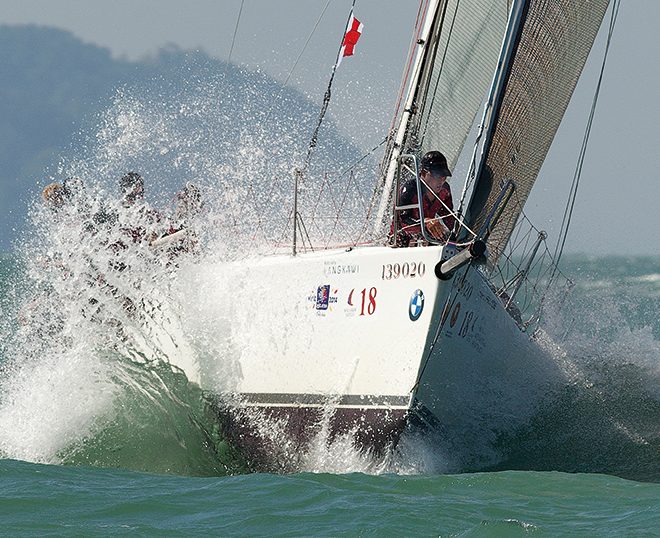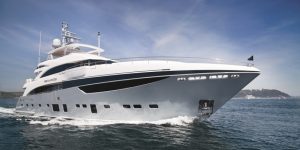9 Asian Sailing Hotspots 2016
With sailing growing in popularity in Asia in recent years, we take a look at the state of play in the region.

Sailing is not something new on the Asian sporting events calendar, and nor is recreational boating. The Republic of Singapore Yacht Club traces its history back to 1826, and the Royal Hong Kong Yacht Club was founded in 1849. Today, sailing and yacht racing are well-developed sports in Thailand, Malaysia, Singapore and Hong Kong. Indonesia, the Philippines, China, South Korea and Taiwan can fairly be called ‘emerging’ when it comes to sailing.
In the 19th century, sailing was the exclusive preserve of the colonial expatriate communities of the big trading cities – principally Hong Kong, Shanghai and Singapore. Today’s sporting landscape is a great deal more cosmopolitan, with nationals as well as ‘foreigners’ filling the membership lists of the clubs, and government initiatives helping to drive the grass-roots development of sailing as a sport, starting with youth programs and going on right up to Olympic participation.
 At the bigger end of the scale – the ocean-capable racing boats – Asia boasts a plethora of regattas that together constitute an informal ‘circuit’ stretching from the west coast of Thailand all the way across to the Philippines, and attracting international competitors from all over the world – hardly surprising when ‘dressed for sailing’ in this part of the world usually means shorts and t-shirts rather than heavy duty foul weather clothing!
At the bigger end of the scale – the ocean-capable racing boats – Asia boasts a plethora of regattas that together constitute an informal ‘circuit’ stretching from the west coast of Thailand all the way across to the Philippines, and attracting international competitors from all over the world – hardly surprising when ‘dressed for sailing’ in this part of the world usually means shorts and t-shirts rather than heavy duty foul weather clothing!
Most recently, Asia has played host to a number of the world’s most highly visible professional sailing events. The Volvo Ocean Race has visited Singapore and China, and will stop over in Hong Kong during its next iteration. Malaysia and South Korea have hosted World Match Racing Tour events, and the Clipper Around the World Race has been to Hong Kong, China, Singapore and Indonesia. And don’t forget the Olympic Regatta at Qingdao in 2008.
Among the Asian nations, China has made the biggest impact on the Olympic scene, with two gold medals in consecutive Games. Hong Kong boasts just one, and the rest of the roll call have none although Singapore, Malaysia and Indonesia are regular qualifiers. Predictably enough, different countries and places display different strengths when it comes to sailing.
HONG KONG
Historically speaking, Hong Kong has long been the epicenter of sailing and yacht racing in Asia. The China Sea Race, Asia’s ‘blue water classic’ from Hong Kong to the Philippines, has been a fixture on the calendar for over 50 years, and the number of races organized by Hong Kong’s principal yacht clubs in the course of a year is counted in the thousands. ‘Class’ boats such as Flying Fifteens, Etchells and Dragons make up big numbers for racing in Victoria Harbour, along with many top-end racing yachts and a huge number of cruisers and cruiser-racers. Boats from all the yacht clubs are welcome at each other’s regattas, and the sailing season is practically year-round. Many racing boats head south and west each year to participate in major regattas and races in Thailand and Malaysia.
Hong Kong’s biggest operational problem is lack of moorings – all the existing marinas are fully occupied and have been for many years, and there are no viable plans for new marinas under consideration.
The principal sailing clubs are the Royal Hong Kong Yacht Club, Hebe Haven Yacht Club, Aberdeen Boat Club, Tai Po Boat Club, Lantau Boat Club, Discovery Bay Boat Club and the HK Hobie Fleet. Sail training and learn-to-sail courses are offered by almost all the clubs, and also at Government-run sailing centers. The governing body for sailing is the Hong Kong Sailing Federation, the Member National Authority where the big ticket items such as the Olympics are concerned, and the national body for training sailing athletes is the Hong Kong Sports Institute which currently designates sailing as an ‘elite’ sport, meaning that national funding is available for the development of Olympic and World Championship campaigns.
Club-organized regattas and racing series include the China Coast Regatta, Spring and Autumn Regattas and the Top Dog Trophy series of pursuit races, and the Hong Kong to Hainan Race, all run by the Royal Hong Kong Yacht Club (RHYC). Hebe Haven Yacht Club’s principal event is the Typhoon Series run on alternate weekends throughout each summer, the Port Shelter Regatta and a number of Saturday-afternoon series’ all through the year. It also includes in its annual program a 24hr Charity Dinghy Race, and offers sail training courses throughout the year. The Aberdeen Boat Club (ABC) organizes racing on the south side of Hong Kong, including the Waglan Series, and both the ABC and RHKYC have substantial dinghy and sail training operations from their alternate clubhouses at Middle Island (Tong Po Chau). All the Clubs’ courses range from Beginner to Racing Clinics levels.
The Leisure and Cultural Services Department of the Hong Kong Government operates five public watersports centres, offering a multitude of certification courses in dinghy sailing, windsurfing, dinghy racing and more.
Hong Kong is a fabulous place for sailing: it has an extensive and beautiful coastline, with sheltered waters as well as areas of feistier breeze. It’s hot in the summer, but never cold enough in the winter to stop the enthusiasts from getting out on the water. In fact, the only time that sailing gets shut down is when a T3 (or higher) typhoon signal keeps everyone ashore for reasons of safety and insurance.
In 2018 Hong Kong will welcome the Volvo Ocean Race to Victoria Harbour. With government backing, a visit from one of most important events in the sailing world will undoubtedly provide encouragement across the board for all sailors in Hong Kong, big and large alike.
Clubs, Marinas and Sailing Associations
• Hong Kong Sailing Federation www.sailing.org.hk
• Government Watersports Centres www.lcsd.gov.hk/watersport
• Royal Hong Kong Yacht Club www.rhkyc.org.hk
• Hebe Haven Yacht Club www.hhyc.org.hk
• Aberdeen Boat Club www.abclubhk.com
• Aberdeen Marina Club www.aberdeenmarinaclub.com
• Clearwater Bay Golf & Country Club Marina www.cwbgolf.org
• Gold Coast Yacht & Country Club www.gcycc.com.hk
• Club Marina Cove www.clubmarinacove.com
• Discovery Bay Marina www.dbmarinaclub.com
THAILAND
The area around Phuket and Phang Nga Bay on the west coast of Thailand is one of the premier cruising areas of Asia, and is making concerted efforts to attract international superyacht traffic from Europe and beyond, with the intention of becoming both the hub of the charter industry in, and the gateway to, Asia.
Thais have long been enthusiastic sailors, mostly because the King of Thailand, His Majesty King Bhumiphol Adulyadej, was once a sailor. As a young man he built his own dinghies, sailed across the Gulf of Thailand, and won a sailing gold medal in the South East Asia Peninsula Games in 1967. His daughter came second.
On the west coast of Thailand, from Phuket to Langkawi (Malaysia), and a sprinkling of islands provides delightful cruising grounds, and Phang Nga Bay is world-famous for its spectacular karst islands and ‘hong’ formations. Think James Bond Island, in The Man with the Golden Gun. Further afield, Phuket constitutes a convenient jumping-off point for cruisers wishing to visit the Mergiu Archipelago (Burma), the Andaman Island and Nicobar Islands (India), the Similan Islands (Thailand) or the west coast of Sumatra (Indonesia) for some of the best and most secluded surfing on the planet.
On the other side of the Kra Peninsular, high spots in the Gulf of Thailand are Koh Samui and Koh Phangan and their surrounding marine sanctuary, the Royal Varuna Yacht Club and Ocean Marina Yacht Club at Pattaya and Jomtien Beach, respectively, and the tropical idylls of Koh Chang and Koh Kut down towards the border with Cambodia.
Thailand presents five major international regattas each year:
• Phuket King’s Cup, held in December in celebration of His Majesty’s birthday
• Phuket Raceweek, a ‘green season’ regatta in July each year and intended to take advantage of the summer southwest monsoon winds
• Bay Regatta – “a party on the move” – in Phang Nga Bay
• Top of the Gulf Regatta at Na Jomtien, which includes the Thailand Optimist National Championships and the Coronation Cup (another Royal occasion)
• Koh Samui Regatta – complete with coconut trophies, Brazilian dancing girls, plenty of breeze, and the splashiest closing dinner of them all.
The majority of the big boats in Thailand are owned and raced by expatriates, but at the smaller end of the scale there is a hotbed of talent in the Optimist and dinghy classes just waiting to shine. Noppakorn Poonpat (THA) won the Optimist World Championships at 20, and there are plenty of successors waiting to step into her shoes. The Thai Optimist Nationals is one of the hardest-fought of the regional championships, with (this year) 140 entries.
The national authority, the Yacht Racing Association of Thailand (YRAT), is largely the preserve of retired Admirals from the Royal Thai Navy (and the RTN turns out every year to take the salute at the Phuket King’s Cup Sail-Past). Phuket, Koh Samui, Ocean Marina and the naval base at Sattahip are the principal centers for teaching young sailors.
Little-known fact: the Platu 25, designed by Bruce Farr in the early 1990s, was created for the waters and weather conditions of the Gulf of Thailand. A syndicate of local sailors commissioned the ‘pla-tu’ which means ‘mackerel’ in Thai.
Clubs, Marinas and Sailing Associations
• Yacht Racing Association of Thailand www.yrat.or.th
• Royal Varuna Yacht Club, Chonburi, Pattaya www.varuna.org
• Ocean Marina Yacht Club, Chonburi, Pattaya www.oceanmarina.asia
• Yacht Haven Phuket www.yacht-haven-phuket.com
• Boat Lagoon Phuket www.phuketboatlagoon.com
• Phuket Cruising Yacht Club www.phuketcruisingyachtclub.org
SINGAPORE
Singapore is home to the oldest yacht club in Asia – the Republic of Singapore Yacht Club (RSYC), formerly the Royal Singapore Yacht Club, and founded in 1826. Situated at the southern end of Malaysia, Singapore is said to preside over the busiest commercial waterway in the world, and this has become a matter of import in recent years.
RSYC has its own facilities and marina, and so does Raffles Marina and the Singapore Armed Forces Yacht Club (SAFYC). The last sailing center in Singapore is the Changi Sailing Club, seemingly always under some sort of threat of redevelopment, but still alive and kicking today.
In 1923 RSYC became the guardian of the Lipton Challenge Cup, awarded to the Club by Sir Thomas Lipton. In recent years this was awarded to the aggregate winner of the Phuket King’s Cup Regatta, the Raja Muda Selangor International Regatta and the Singapore Straits Regatta. The latter event has fallen by the wayside as the Marine & Ports Authority of Singapore has imposed ever-more draconian restrictions on the operations of pleasure vessels, and particularly sailing yachts. Sadly, the Lipton Cup is now housed in the Singapore Sports Museum.
The top event in Singapore is now a mixed fleet regatta, the Western Circuit, organized by the Singapore Management University – a very active collection of students and alumni – and hosted by Raffles Marina. The Neptune Regatta is a small fleet that sails and races from Nongsa Point Marina in Batam to Pulau Sikeling in the Riau Archipelago. Technically this all takes place within Indonesia, but in reality it is a ‘Singapore’ event.
If big boats and club racing has waned in recent years, the activities of the government-supported Singapore Sailing Association goes from strength to strength. Sailing is a sport now on the school curriculum, and every year thousands of young people are introduced to the sport, sailing Optimist and Topper dinghies and maybe moving on to the 420 and Olympic 470 and Laser classes. Singapore has been a multiple medal winner at many sailing youth championships, and hosted the inaugural Youth Olympics in 2010. Eight Singaporeans have qualified for the 2016 Olympics in Rio de Janeiro.
Unfortunately, the young sailors don’t seem to graduate to bigger boats. Governmental initiatives are geared towards producing junior champions and hopefully Olympic medals, and the grown-up version of racing sailing is not on the agenda.
Singapore, which hosted an event in the Extreme Sailing Series for five years, also entertained the Clipper Around the World Race and the Volvo Ocean Race. There are world-class facilities in the shape of ONE˚15 Marina at Sentosa Cove (home to Asia’s number one boat show, the Singapore Yacht Show) and Marina at Keppel Bay. Singapore has the facilities, but not the space in which to sail. A country that once fielded teams for the Admiral’s Cup, can do so no longer.
Clubs, Marinas and Sailing Associations
• Singapore Sailing Federation www.sailing.org.sg
• Changi Sailing Club www.csc.org.sg
• Raffles Marina www.rafflesmarina.com.sg
• Republic of Singapore Yacht Club www.rsyc.org.sg
• ONE˚15 Marina Club www.one15marina.com
• Marina at Keppel Bay www.marinakeppelbay.com
MALAYSIA
Malaysia boasts long coastlines on the west and the east of the country, peppered with historic towns and beautiful beaches, and sprinkled with jewel-like islands that make it a playground for the cruising sailor.
The west coast of Malaysia is 400nm from north to south, and includes the fabulous archipelago of Langkawi, historic Penang (“The Pearl of the Orient”), picturesque Pangkor and the beautiful old city of Malacca – which, along with Penang, is a UNESCO Heritage Site. Throw in a plethora of beautiful beaches, the blessing of equable tropical weather, and just ‘go sailing’. Pulau Tioman is the star of Malaysia’s east coast, and then the Anambas Islands if you are prepared to sail 130nm or so offshore.
Across the South China Sea there is the north coast of Borneo – the provinces of Sabah and Sarawak are Malaysia, too. This is known as ‘The Land Below the Wind’ on account of the lack of typhoons this far south, and here the attraction for sailors is not so much sandy beaches but history (Kuching), mountaineering (Mt Kinabalu) and the culture of the littoral Dayak tribes.
The national authority for sailing is the Malaysian Sailing Association (MSA), based in Kuala Lumpur, and operating a major dinghy training centre in Langkawi, which is popular with international visitors for training camps. The MSA also organizes the Liga Layar, a national match racing series.
Langkawi is very much the de facto center of sailing in Malaysia. It has three major marinas (Royal Langkawi Yacht Club, Rebak Marina Resort and Telaga Harbour) and is close to the border with Thailand, making the island’s Duty Free status very attractive to passers-by heading north, and also to boats voyaging south from Phuket in order to stock up on everything from gin to fuel. The Youth World Sailing Championships were held in Langkawi in early 2016, based out of the MSA facility.
The principal private clubs in Malaysia are the Royal Selangor Yacht Club at Port Klang, which organizes the annual Raja Muda Selangor International Regatta, and the Royal Langkawi Yacht Club, home of the Royal Langkawi International Regatta (RLIR). Both events attract entries of around 30 big boats. The ‘Raja Muda’ is a peripatetic affair featuring both coastal passage and in-port racing, travelling from Port Klang to Langkawi. It is a difficult and exhausting event over the space of a week – the sailing can be tough, but you need additional stamina for the social side of the event! The RLIR is an in-port event conducted amongst the fairy tale islands of Langkawi, but it is a one-off yearly event – the only other time in a year that racing takes place is when the Raja Muda fleet arrives. There are yacht clubs at Kinabalu (Sabah) and Piasau (Sarawak), as well as Tawau and Sandakan on the east coast of Borneo, but these are places to visit rather than establishments that organise regattas and racing.
In common with other SE Asian countries, the governmental initiative in Malaysia is geared towards youth development, dinghy sailing, and the eternal search for an Olympic medal. The Optimist class is strong all round the country, and sends young competitors to international events, but in common with other Asian countries, that’s as far as it goes – most governments, with the possible exception of Thailand – have not yet woken up to the huge economic potential offered by the promotion of sailing, boating, marine tourism and the full development of a leisure marine industry. Sailing in Malaysia does however benefit from the active participation of the Royal Malaysian Navy which owns and runs two 47’ racing boats, and the cooperation of the Royal Malaysian Police who provides exceptional backup services and materiel for major international big boat events.
The big boats and the clubs and events that they visit are pretty much self-sufficient. Training programmes to IYT certification are offered by Sail Training Malaysia (Pulau Indah Marina, Port Klang), and Asian Yachting Ventures at Port Dickson signs off on Asian Coastal and Yachtmaster courses.
Clubs, Marinas and Sailing Associations
• Malaysian Sailing Association sailmalaysia.org
• Royal Selangor Yacht Club www.rsyc.com.my
• Sebana Cove Resort & Marina, Johor Bahru www.sebanacoveresort.com
• Royal Langkawi Yacht Club www.langkawiyachtclub.com
• Telaga Harbour Park & Marina, Langkawi www.telagaharbour.com
• Rebak Marina Resort, Langkawi www.rebakmarina.com
• Sutera Harbour Marina, Sabah www.suteraharbour.com
CHINA
When China decides to get involved in something, they don’t do it by halves. In the case of sailing, that has meant an America’s Cup entry, a Volvo Ocean Race team, and any number of lavish-looking marinas constructed on the principle of “build it and they will come,” but more likely to be a marketing ‘hook’ for a surrounding property development. The encouragement of sailing often appears to be a ‘top down’ rather than a ‘bottom-up’ endeavour.
The most visible regatta in China is the China Cup International Regatta. This four-day event has a number of one-design divisions that includes a fleet of 30 Beneteau 40.7 yachts that can be chartered, as well as IRC racing divisions, but the top level Grand Prix boats are still missing. There are a number of other regattas, some on lakes and some on rivers, as well as a growing interest in match racing that is engaging sailors at the grass roots level. The China Club Challenge Cup is probably the most ‘genuine’ of the China regattas.
China still lacks a coherent, federal-scale, policy concerning leisure and pleasure boats. Until the day comes that you can confidently write “Private Yacht” on the registration application, and until you can sail out of Xiamen and back into Fujian knowing that the regulations are the same in both places, any development of a marine leisure culture will remain stalled, despite the excellent sporting example of two gold medals in successive Olympics.
The most visible yacht clubs in China do not necessarily have much to do with sailing.
Clubs and Sailing Associations
• China Yachting Association sailboarding.sport.org.cn
• Shanghai Boat and Yacht Club www.shanghaibyc.org
• Iron Rock Sailing Club, Xiamen www.ironrocksailing.com
INDONESIA
Indonesia is practically the definition of ‘archipelago’, and is making itself felt in the luxury charter market as an exotic destination. Komodo dragons and the Spice Islands beckon. For divers there is the Coral Triangle and the Raja Ampat, the most biodiverse marine ecosystems on the planet, and the Wallace Line, separating the ecology of the old world from Australasia,cuts through the middle of the country.
Indonesia hosts the Sail Indonesia Rally each year, with boats coming up from Australia, passing through the archipelago east to west by a different route every time, and then moving on towards Malaysia.
The Neptune Regatta departs Nongsa Point (directly opposite Singapore) and does a sort of ‘racing adventure cruise’ to the Equator and back every year – on the chart it’s an Indonesian event, but it is all Singapore-organized. There’s very little local recreational sailing going on, with the exception of the famous Sandeq Race for the local fishing boats along the west coast of Sulawesi. The Indonesia Sailing Federation regularly manages to get a qualifier into the Olympics.
Clubs and Sailing Associations
• Indonesian Sailing Federation
• Jakarta Offshore Sailing Club
• Nongsa Point Marina, Batam www.nongsapointmarina.com
• Sail Indonesia www.sailindonesia.net
THE PHILIPPINES
In the 1990s there was a flourishing sailing scene based around the Manila Yacht Club (MYC), Flying 15s, Dragons, and a fair collection of big boats. In 1994 the Philippine Easter Regatta attracted a 60-strong fleet that raced from Manila to Corregidor, and then on to Subic Bay. The MYC used to be the finish line for the China Sea Race, and many a salty tale was expanded over the bar on Roxas Boulevard. Glory days indeed.
Then the MYC stopped organizing races, the few remaining sailing members decamped to Subic Bay, and everything fizzled out by degrees. The biggest active club in the Philippines is now the Puerto Galera Yacht Club, which very deliberately does not take itself too seriously.
The Commodores’ Cup at Subic attracts 6-8 boats only, even when the China Sea fleet has just arrived – and departed. The Boracay Cup (preceded by the Subic-Boracay Race) should be the jewel in the glittering tropical crown, but rarely attracts more than a handful of entries
Clubs and Sailing Associations
• Philippines Sailing Association www.philsailing.com
• Puerto Galera Yacht Club www.pgyc.org
• Subic Sailing subicsailing.org
TAIWAN
It is only recently that people in Taiwan have been allowed to set foot on a beach. Fishermen went fishing, but the coastline was off-limits to all non-military personnel. There has been an entirely successful sailing and motor yacht building industry in the Kaohsiung area for three decades, producing boats that were strictly for export. Only.
With the easing of coastal regulations, a couple of small regattas have sprung up, organized by the Taiwan Sailing Association. The Penghu Regatta takes place in the delightful Penghu Islands in the Taiwan Strait, a place with plenty of wind that has long been popular with windsurfers from all over the world. The inaugural Taiwan Boat Show was a sell-out, and the second one (in March) followed suit. Brokers report good business. Watch this space.
Clubs and Sailing Associations
• Taiwan Sailing Association www.taiwansail.org
• Chinese Taipei Sailing Association www.sail-clubs.com
SOUTH KOREA
The west coast provides challenging conditions for sailing – coastal mudflats for hundreds of miles when the 10m tide goes out. The east coast consists mostly of small squid-fishing villages. The south coast, from Mokpo to Busan via Jeju Island, is beautiful but with the exception of the Olympic Marina (1988) at Busan, ‘undeveloped’ in sailing terms.
Provincial authorities kick started the Korea International Boat Show in 2008, and inaugurated the WMRT Korea Match Cup in the same year. The Wangsan Marina near Incheon, was built for the 2014 Asian Games regatta, and was intended to become a public marina with amenities and services catering to domestic as well as international boaters.
A small number of races venture offshore: there’s one to Ulleung-do and Dok-do to the east of Korea, and one from Mokpo to Jeju if the weather permits. There’s an Admiral’s Cup regatta in Busan, and the Women’s International Match Racing Association has also been there.
‘Boating culture’ has been slow to develop in Korea, in spite of government initiatives to stimulate interest. Leisure time is a relatively new commodity in this hard-working country and, rather like China, Korea might do well to start at the bottom and work upwards, rather than the other way round.
Sailing Association
• Korea Sailing Federation www.ksaf.org









